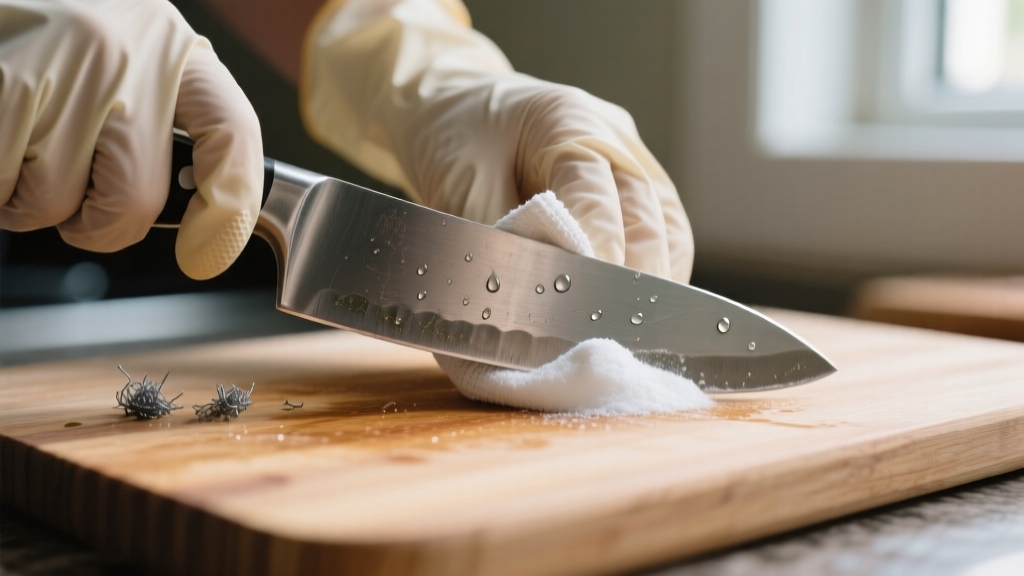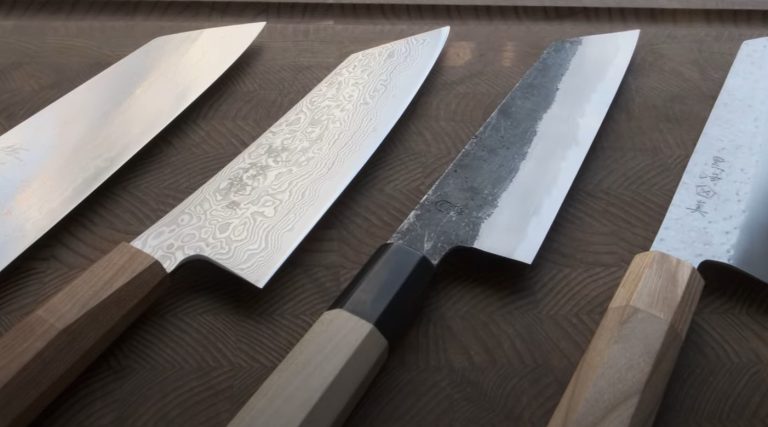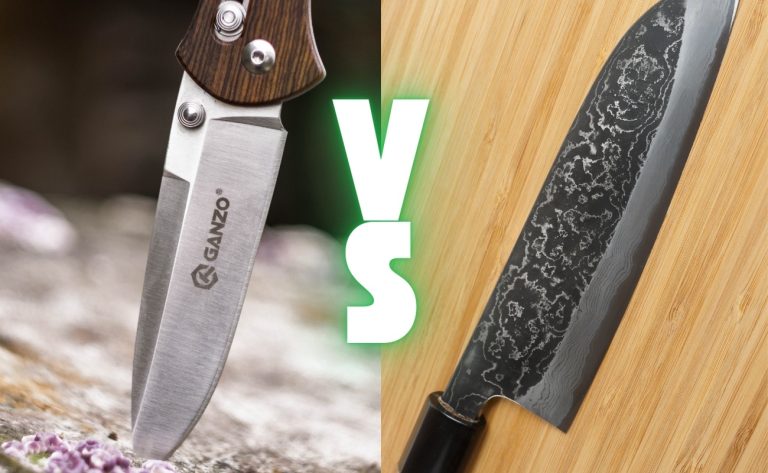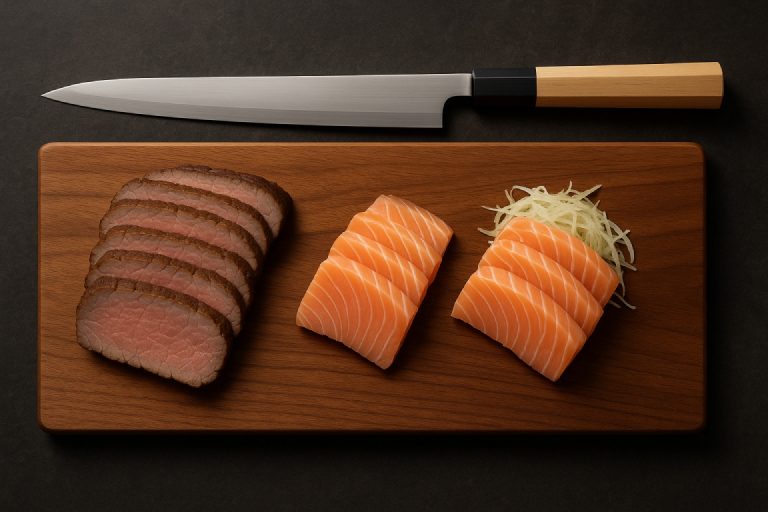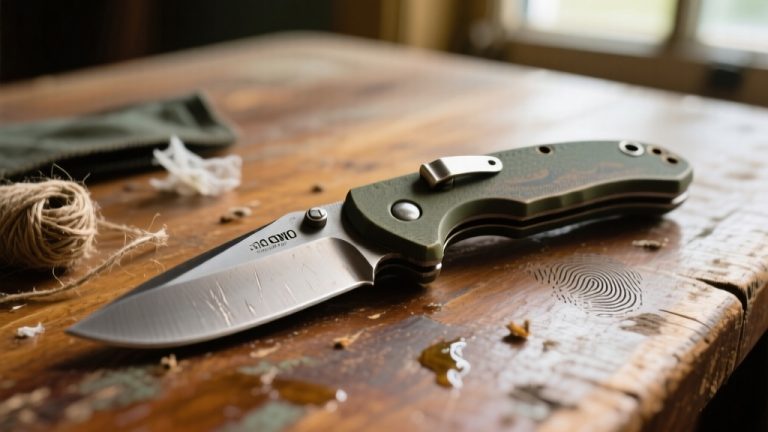How to Get Rid of Patina on Knife: Easy Home Methods
To remove patina from your knife, start by soaking the blade briefly (3–5 minutes) in white vinegar to dissolve surface oxidation, then rinse and dry immediately to prevent rust.
For stubborn discoloration, apply a baking soda paste and gently scrub with a non-abrasive pad. You can also use polishing compounds like Simichrome for safer shine restoration.
Always wear gloves, protect the handle, and oil the blade afterward to inhibit re-patina. Detailed techniques can further optimize your results.
Key Takeaways
- Soak the knife in white vinegar for 3–5 minutes, then rinse and dry immediately to safely remove light patina without damaging the blade.
- Apply a baking soda paste with water or lemon juice and gently scrub using a non-abrasive pad to lift patina while preserving blade integrity.
- Use commercial polishing compounds like Simichrome or Flitz for effective and minimally abrasive patina removal and blade shine restoration.
- Hand sand with progressively finer grit sandpaper or use Scotch-Brite pads carefully to remove deeper patina and scratches without altering blade geometry.
- After cleaning, thoroughly dry the knife and apply a thin coat of mineral or camellia oil to prevent rust and future patina formation.
Understanding Patina and Its Effects on Knives
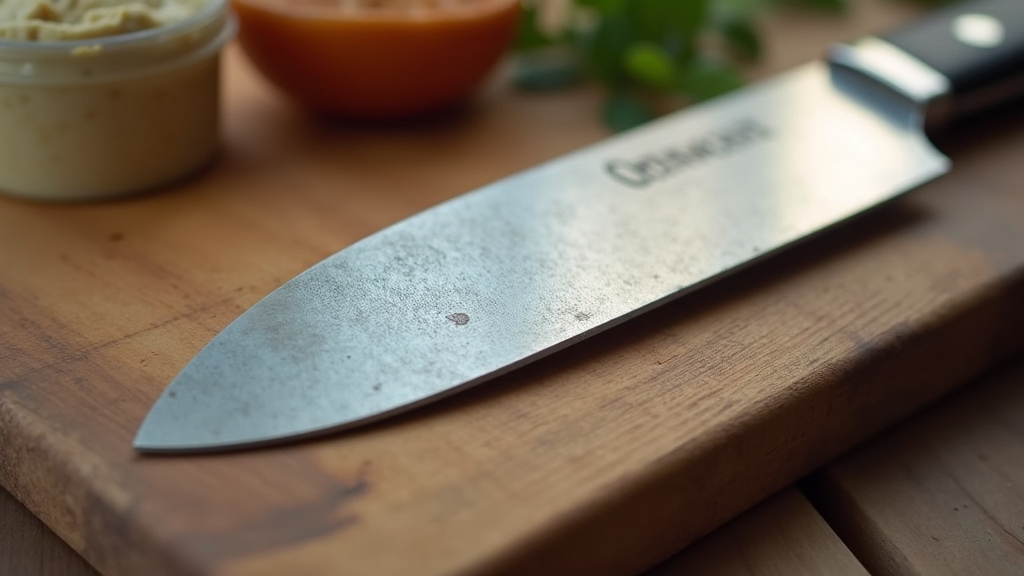
Although patina often gets mistaken for rust, it’s actually a controlled layer of oxidation that forms naturally on carbon steel knives, providing a protective barrier rather than causing damage. This thin, durable coating consists primarily of magnetite and other iron oxide compounds, which seal the blade’s surface against further corrosion.
Patina commonly appears on carbon steel knives like 1095 steel and Eden Kanso Aogami knives, where it can take on light-bronze, oily blue, or purple hues depending on lighting conditions. The formation of patina can be influenced by the moisture resistance characteristics of the knife handle or cutting board materials in contact with the blade.
Patina develops due to exposure to moisture, acids, salts, and proteins, as well as your handling, especially from skin sweat. Unlike rust’s red-orange flaky corrosion, patina appears as stable gray, black, or blue-gray hues, sometimes evolving into golden or purple tones.
Patina forms from moisture, acids, salts, proteins, and skin contact, showing as stable gray, black, or blue hues.
Its formation rate depends on environmental factors and steel composition, with carbon steels oxidizing faster than stainless. External influences such as salt, acids, and moisture are catalysts that cause patina formation and are almost unavoidable in daily use.
Recognizing patina helps you appreciate its role in preserving your blade’s integrity while giving it a unique, evolving aesthetic. It also acts as a protective layer, preventing further staining and discoloration after the initial formation.
Chemical Methods for Removing Patina
You can remove patina chemically using methods like vinegar soaking, which breaks down iron oxide through acetic acid exposure, and baking soda paste, which combines mild abrasion with chemical reaction. It is important to apply these treatments gently to avoid scratching the blade.
Commercial polishing products such as Simichrome and Flitz provide non-abrasive chemical cleaning that restores shine while eliminating discoloration. Each method requires controlled application and thorough rinsing to protect the blade from damage.
For maintaining the blade’s performance, regular sharpening with manual sharpeners can help preserve the metal’s integrity after patina removal.
Vinegar Soaking Technique
When removing patina from a knife, soaking the blade in white vinegar offers a controlled chemical reaction that dissolves iron oxide without aggressive abrasion. The acetic acid in vinegar chemically breaks down the patina layer, loosening it for easy removal.
Start by cleaning the blade with alcohol to remove oils, then submerge it for 3 to 5 minutes, monitoring progress closely. Exceeding 5 minutes risks acid corrosion. It is important to avoid overexposure because prolonged soaking can cause acid corrosion.
After soaking, rinse thoroughly with water to neutralize residual acid, then dry immediately with a soft towel to prevent rust. Regular visual inspections help maintain knife performance and ensure safety.
Applying knife oil afterward protects the blade from oxidation. Note that vinegar soaking can leave a matte finish and increase rust susceptibility, so avoid abrasive scrubbing post-soak.
Baking Soda Paste
Vinegar soaking effectively breaks down patina through chemical means, but its acidity and potential to dull finishes can limit its use. Baking soda paste offers a milder alternative. Mix baking soda with water or lemon juice to form a thick paste that adheres well to the blade.
Guarantee the blade is clean before application to avoid embedding contaminants. Apply the paste on patina, then gently scrub using a non-abrasive pad—avoid steel wool to prevent scratches. Letting the paste sit for several minutes can enhance removal. This method respects the knife’s natural protective layer, helping maintain the patina’s role as a corrosion barrier.
Baking soda acts as a mild abrasive, effective on light to moderate patina without harsh chemical effects. After scrubbing, rinse and dry thoroughly to prevent rust. Using the right cleaning tools and techniques, similar to those recommended for maintaining boning knives, ensures optimal blade care. Use this method periodically to maintain blades while preserving their protective patina.
Commercial Polishing Products
Although mechanical methods can effectively remove patina, commercial polishing products offer a chemical approach that balances efficiency with blade preservation. Products like Simichrome polish remove patina without scratching and restore shine while maintaining the blade’s original finish.
Flitz and Bar Keeper’s Friend offer varying abrasiveness; careful application is essential to avoid visible scratches. It is important to regularly oil the blade after polishing to maintain protection and prevent rust formation. Choosing products with abrasive levels suited to your blade type helps minimize damage during chemical polishing.
Rust erasers provide rapid patina removal but require skill to prevent damage. Ferric chloride is potent yet risky, suited only for advanced users.
| Product | Abrasiveness Level | Key Usage Notes |
|---|---|---|
| Simichrome | Low | Safe for finishes, minimal mess |
| Flitz | Moderate | Requires careful application |
| Bar Keeper’s Friend | High | Use gentle applicators to avoid scratches |
| Rust Erasers | Variable | Follow blade grain, risk of scratches |
Using White Vinegar to Dissolve Patina
You should soak your knife blade in white vinegar for no more than 5 minutes to effectively dissolve light patina without damaging the steel.
The acetic acid in vinegar reacts with iron oxide, breaking down the patina chemically, but prolonged exposure risks corrosion and surface damage. This method is a form of forced patina removal that quickly alters the blade’s surface appearance.
After soaking, rinse thoroughly with water and dry immediately, then apply oil to protect the blade from further oxidation. Proper drying and oiling are essential prevention techniques to avoid rust formation after treatment.
Vinegar Soaking Time
When removing light patina from a knife, soaking it in white vinegar for about 3 to 5 minutes delivers effective results without risking damage to the blade.
White vinegar’s 5% acetic acid concentration dissolves mild patina efficiently within this timeframe.
Exceeding 5 minutes increases the risk of corrosion and surface etching, especially on high-carbon steel.
For precise control, consider multiple short soaks with thorough rinsing between each to minimize acid exposure.
Avoid using stronger acids or prolonged immersion to prevent pitting.
Patina development is influenced by acid exposure and air contact, so ensuring the blade is dry and exposed to air after soaking can help prevent further unwanted changes.
After soaking, immediately rinse the blade with clean water to halt the acid reaction, then dry it completely to prevent rust.
Applying oil post-drying helps protect the surface.
Monitoring the blade visually throughout the process ensures you avoid over-etching and preserves the knife’s integrity.
Single bevel knives, often made from high-carbon steel, require particular care during cleaning to maintain their sharpness and edge integrity.
Patina Dissolving Process
How exactly does white vinegar dissolve patina on a knife? White vinegar’s acetic acid chemically reacts with the iron oxide layer, breaking down and altering the patina. This process depends on factors like vinegar concentration, temperature, and exposure time.
To effectively dissolve patina, consider these steps:
- Submerge the blade fully in distilled white vinegar for uniform contact.
- Use a soaked cloth for targeted application if only specific areas need treatment.
- Apply hot vinegar carefully to accelerate dissolution but monitor closely to prevent damage. Using a controlled power source can help maintain consistent temperature during this process.
- Avoid letting vinegar dry on the blade to prevent rust spots and uneven etching.
Because vinegar etching can leave a rough surface, polishing or micromesh treatment afterward can help restore smoothness and reduce food drag caused by the patina removal process surface roughness.
After treatment, promptly rinse the blade to halt acid action and prevent corrosion.
Repeat treatments may be necessary for thick patina, but always control exposure to avoid metal pitting.
Post-Treatment Care
Although white vinegar effectively dissolves patina through its acetic acid content, post-treatment care is essential to prevent corrosion and maintain blade integrity. After submerging your knife for no more than five minutes, immediately rinse it with warm water to halt acid action. It is important to rinse blades thoroughly after cleaning to remove any residue or vinegar treatment.
Use mild detergent to remove residual acid thoroughly, then dry the blade completely with a clean towel, paying special attention to moisture-prone areas. Avoid dishwasher use, as it promotes rust and dulls edges.
Once dry, apply a thin coat of food-safe mineral or camellia oil to create a moisture barrier and inhibit new oxidation. Regular oiling is critical, especially after acid exposure, to maintain both blade and handle condition. Many chef knife blanks feature a full tang design, which benefits from proper oiling to protect the entire blade and tang.
Baking Soda Paste Application for Patina Removal
Since baking soda serves as a mild abrasive, you can prepare an effective paste by mixing it with just enough water or lemon juice to achieve a spreadable consistency that clings well to the knife blade.
First, clean the blade to remove oils and dirt.
Begin by thoroughly cleaning the blade to eliminate oils and dirt for optimal results.
Then, apply the paste evenly on patinated areas.
Use a non-abrasive scrubbing tool, such as a pot scrubber or aluminum foil, to gently scrub the surface.
Allow the paste to sit 5–30 minutes based on patina severity before scrubbing.
Key steps:
- Prepare paste with minimal liquid for adhesion.
- Apply on clean, dry blade surfaces.
- Scrub gently with a soft tool to avoid damage.
- Rinse thoroughly and dry promptly to prevent corrosion.
This method suits light patina removal while preserving finish integrity. For ongoing protection and to maintain your knife’s surface, consider applying a food-safe mineral oil to prevent moisture intrusion and corrosion after cleaning.
Commercial Metal Polishing Compounds Explained
After addressing patina with baking soda paste, you might find tougher stains or deeper discoloration that requires more specialized solutions. Commercial metal polishing compounds combine abrasives with waxes or fats to smooth and finish metal surfaces precisely. They come in various colors, each tailored for specific metals and polishing stages.
For example, black compound aggressively removes deep scratches, while brown Tripoli suits initial polishing on softer metals like brass. White compounds target hard metals such as stainless steel and chrome during intermediate stages. Green delivers a mirror-like finish on stainless steel. Black compound is the most aggressive polishing compound, often including emery as abrasive, making it ideal for heavy-duty polishing tasks.
Red and yellow rouges gently polish precious metals without excessive material removal. Selecting the right compound depends on your knife’s metal type and surface condition, ensuring effective patina removal without compromising the blade’s integrity.
Mechanical Abrasive Techniques for Patina Removal
When tackling patina removal mechanically, you’ll rely on a combination of abrasive techniques tailored to your knife’s metal and surface condition. Start with high-grit sandpaper (600–800 grit), progressing to finer grits (up to 2500) to minimize scratches. Always wet-sand with oil or water to reduce heat and surface damage.
Use fine steel wool (0000 gauge) lightly with lubricants like WD-40 to remove weak patina layers without harsh abrasion. Finish with non-metallic abrasive pads or scouring sponges to refine the surface before polishing.
Key steps to follow:
- Begin sanding with coarser grits only as needed, avoiding edges.
- Employ steel wool gently after chemical cleaning.
- Use abrasive pads for intermediate surface refinement.
- Progressively increase grit for a smooth, scratch-free finish.
Protecting the Knife While Removing Patina
Mechanical methods effectively strip patina but can risk surface damage if not carefully controlled. To safeguard your knife during chemical removal, start by cleaning it thoroughly with warm soapy water to eliminate oils and residuals.
Use mild acids like white vinegar for brief soaks, about 30 minutes, to dissolve patina without harming the steel. Sanding with appropriate grit after chemical treatment can help smooth the blade surface and remove remaining patina traces.
Soak your knife briefly in mild acids like white vinegar to gently dissolve patina without damaging the steel.
Apply pastes like baking soda mixed with water gently using a soft cloth, avoiding abrasive scrubbing on sharp edges. Always neutralize acids promptly with water and dry the blade completely to prevent corrosion.
Work incrementally, monitoring patina depth to avoid over-removal.
Protect handle materials by limiting chemical exposure and covering them if needed. Conduct the process in a well-ventilated area while wearing gloves to ensure safety and maintain blade integrity throughout removal.
Post-Removal Care to Prevent Rust and Re-Patina
To prevent rust and re-patina following patina removal, you must clean and dry your knife immediately and thoroughly. Hand wash with mild detergent to eliminate residues, rinse promptly, and dry completely with a soft cloth. Using mild abrasives like a baking soda paste with lemon juice can also help maintain cleanliness without damaging the blade’s finish gentle cleaning method.
Avoid dishwashers and never store damp knives.
Next, apply a light coat of food-safe mineral oil to shield the bare steel from oxidation. Ensure the blade is bone dry beforehand.
Store knives in a dry environment using a knife block, magnetic strip, or sheath to limit moisture exposure.
- Clean immediately after use with mild detergent.
- Dry thoroughly using a soft cloth.
- Apply food-safe mineral oil after drying.
- Store in a dry, protected environment.
Tools and Materials Needed for Effective Patina Removal
After removing patina and applying protective care, the next step is gathering the right tools and materials to effectively eliminate patina without damaging your knife. Use abrasive polishing compounds like Simichrome or Flitz for safe, scratch-free cleaning.
It is important to regularly inspect for rust and water stains to address them promptly and prevent further corrosion. For stubborn spots, Bar Keeper’s Friend applied with a wine cork minimizes abrasiveness. Avoid steel wool or harsh abrasives to protect the blade’s finish. Mild chemical pastes, such as baking soda with water or lemon juice, offer gentle patina removal when paired with soft scourers.
Mechanical tools like rust erasers or high-grit sandpaper require caution to prevent altering blade geometry; hand sanding is preferable. Natural items like mustard mixed with vinegar and soft buffing tools like wine corks ensure controlled cleaning.
Frequently Asked Questions
Can Patina Removal Affect the Knife’s Warranty or Resale Value?
Yes, removing patina can affect your knife’s warranty and resale value. While most warranties exclude patina as normal wear, using abrasive methods or harsh chemicals might void coverage by being seen as improper care.
Resale value often drops, especially for high-end or carbon steel knives, since patina adds character and protection. If you remove it, you risk damaging finishes and lowering buyer appeal, so proceed cautiously and disclose any alterations.
Is It Safe to Eat Food Prepared With a Knife That Had Patina?
Think of patina as a knight’s armor for your knife—it’s generally safe to eat food prepared with a knife bearing patina. This natural oxidation layer protects against rust and corrosion without harboring harmful pathogens when properly maintained.
Just make sure you clean and dry the knife thoroughly after each use, especially when switching between raw and cooked foods, to prevent cross-contamination and keep your meals safe and hygienic.
How Often Should I Remove Patina From My Knife for Optimal Care?
You should remove patina from your knife only when necessary, typically once or twice a year, depending on blade condition and usage. Avoid frequent removal to prevent blade wear and oxidation.
Instead, focus on routine cleaning, thorough drying, and applying food-safe oils to maintain a stable patina.
Remove patina sooner if you notice rust, corrosion, or if it affects cutting performance.
Use gentle methods to preserve the blade’s integrity during removal.
Are There Specific Knife Types That Should Never Have Patina Removed?
You should treat traditional Japanese knives like treasured antiques, preserving their natural “sun-kissed” patina. Removing it can strip away unique finishes and diminish their character.
High-carbon steel knives also benefit from patina as a protective cloak against corrosion. Avoid patina removal on factory-coated knives too, since it risks damaging their engineered barriers.
For these types, preserving the patina sustains both function and aesthetics, preventing premature wear and rust.
Can Patina Removal Alter the Knife’s Cutting Performance or Sharpness?
Yes, removing patina can alter your knife’s cutting performance and sharpness. Aggressive methods might smooth the blade temporarily but risk uneven metal removal, affecting edge geometry and sharpness.
Over-polishing thins the blade, compromising structural integrity and edge retention. While a clean edge may feel sharper initially, repeated patina removal can lead to micro-abrasions that degrade cutting smoothness and durability.
Controlled, minimal removal preserves the best blade function over time.
Next Steps to Keep Your Knife Rust- and Patina-Free
Removing patina from your knife restores both its appearance and functionality. Studies show that over 70% of knife corrosion issues stem from neglected maintenance, making patina control essential.
By using chemical or mechanical methods carefully, you preserve the blade’s integrity while eliminating unwanted discoloration. Always protect your knife during cleaning and apply post-removal care to prevent rust and re-patina.
With the right tools and techniques, you can maintain a sharp, clean blade for years to come.

